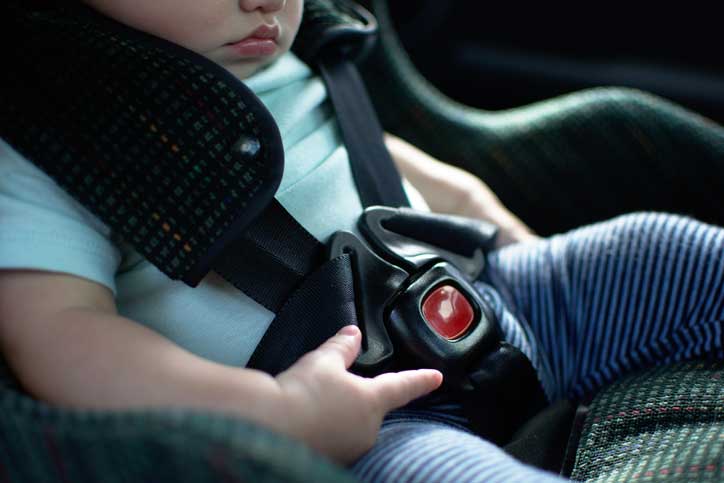By Julie A. Bachert, Esq.
With temperatures rising, you may worry about the tragic headlines of children trapped in overheated cars. Technological advancements have already offered some reprieve, albeit only for pets, as Tesla cars offer a “Dog Mode” that regulates the inside temperature of the car to keep the interior cool for pets and inform passersby that the pets are safe and not in need of rescuing. Surprisingly, new laws have seemingly matched and surpassed such technological advancements, at least in California!
On January 1, 2021, the State of California implemented new laws protecting people from civil and criminal liability for property damage or trespassing when they break into an overheated car to rescue a child. (Assem. Bill 2717, 2019-2020 Reg. Session, ch. 352, 2021 Cal. Stat.; Cal. Civil Code § 43.102; Cal. Health & Safety Code § 1799.101.) For the purpose of these laws, “child” means a person who is 6 years old or younger. (Cal. Civil Code § 43.102; Cal. Health & Safety Code § 1799.101, subd. (c).)
Of course, these laws are not without limitation. Good Samaritans must satisfy the following regimented steps established by these new laws before receiving protection from civil and/or criminal liability for property damage:
- Hold a “reasonable belief” that the child’s safety is in immediate danger;
- Determine the vehicle is locked or there is no way to easily remove the child, such as through an open window;
- Contact the police, fire department, or “911” before breaking into the car to rescue the child;
- Possess a “good faith,” “reasonable” belief that immediate, forcible entry into the vehicle, such as breaking into the car, is necessary to prevent immediate danger to the child;
- Use no more force than necessary to enter the car and remove the child;
- Remain with the child in a “safe” location, “out of the elements but reasonably close to the vehicle,” until emergency personnel arrive; and
- Immediately turn the child over to emergency personnel that arrive on the scene. (Cal. Health & Safety Code § 1799.101, subd. (a)(2)(A)-(F).)
These 7 steps seem logical and rational, but perhaps, fail to consider that Good Samaritans might not be acting logically and rationally when trying to save a child from imminent danger. Imagine this scenario: a Good Samaritan sees a child sleeping or passed out in an unsupervised, locked car on a not-so-uncommon day in Southern California when it is over 100 degrees outside and he or she immediately acts on impulse to rescue the child without calling emergency personnel first. This Good Samaritan has good intentions, but fails to follow one of the 7 steps, and as such, is not exempt from civil and/or criminal liability for breaking into the car to rescue the child.
Imagine another scenario: the Good Samaritan that broke into the car to rescue the child must leave the scene due to some other personal emergency and is not the same person who stays with the child until emergency personnel arrive on the scene. Again, this Good Samaritan could face civil and/or criminal liability for breaking into the car because he or she failed to follow one of the 7 steps outlined by the new law.
Likewise, what qualifies as a “good faith,” “reasonable” belief is entirely unclear. For instance, a Good Samaritan might break into an overheated car believing that a child is passed out and in need of immediate rescue, but what if the child has only been left unattended for a few minutes and is merely sleeping? Hopefully, the Good Samaritan would fall within the purview of the new law if he or she breaks into the car to rescue the child under his or her good faith, reasonable belief that such actions were necessary to prevent immediate danger to the child, but the ambiguity of the language of “good faith,” “reasonable” belief leaves the Good Samaritan vulnerable to civil and/or criminal liability for property damage.
Of course, the rescued child must also be 6 years of age or younger to qualify under the new law. What if the child appears 6 years old, but is actually 7 years old? According to the new law, the Good Samaritan would not be exempt from civil and/or criminal liability for rescuing a minor who is over 6 years old.
Another important limitation imposed by the new law is that, even if the Good Samaritan follows the 7 not-so-easy steps, he or she is still only immune from civil or criminal liability for damage or trespass to property. Thus, if the child is somehow injured during the rescue process, the Good Samaritan is not immune from civil or criminal liability for such personal injuries to the child.
Like the intent of Good Samaritans, the intent of the new laws is honorable and aims to protect children left in hot cars as well as Good Samaritans who rescue them. Now that we are well into Spring and the days are getting warmer, it is always a good reminder to never leave young children (or your pets) alone in a car, not even for a moment.


